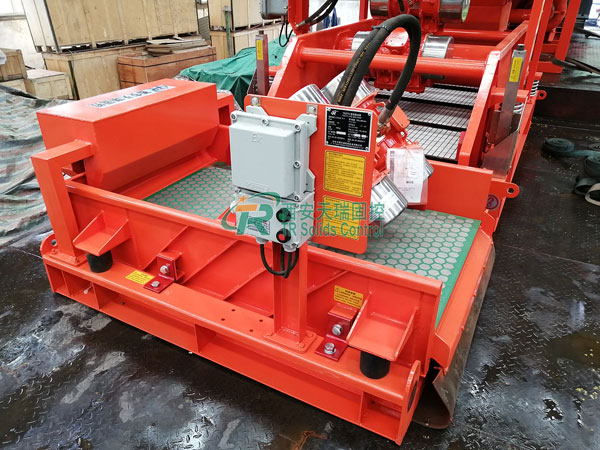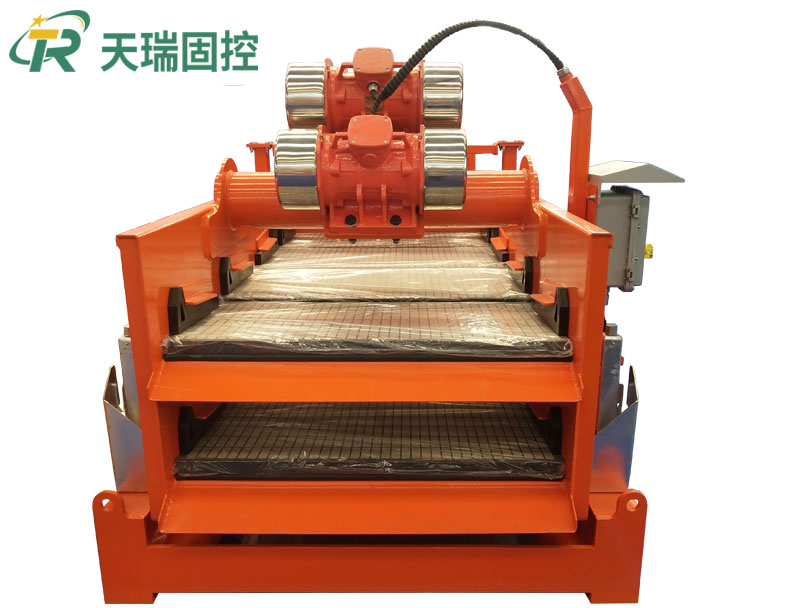Shale shakers are among the most fundamental pieces of equipment in the solids control system of drilling fluids in the oil and gas industry. Their primary application is the efficient separation of solid particles (or mud) from drilling fluid during the drilling process. This process is crucial for maintaining the integrity and efficiency of the drilling fluid, preventing damage to downstream equipment, and ensuring safe and efficient operation.
TR Solids Control's shale shaker is the core equipment of the drilling fluid circulation system, undertaking the initial purification task. It is responsible for removing rock cuttings and large solid particles with a particle size ≥74μm, and its processing capacity accounts for more than 80% of the total solids control system volume. Its performance directly affects the load of downstream equipment (such as desanders and centrifuges) and the stability of drilling fluid performance. It is a key link in ensuring drilling efficiency, reducing equipment wear, and controlling costs.

The drilling fluid shale shaker mainly consists of a base, screen box,shaker screen, excitation motor, damping springs, and control device.
The first step in solids control is called primary solids removal, which involves the mud flowing back from the drill string to the wellbore during circulation, passing through a shale shaker that vibrates on the surface. Larger solid particles are separated from other cuttings by the shale shaker, which has different mesh sizes. In this way, primary solids removal helps extend pump life and optimizes drilling time by minimizing downtime caused by damage to pumps or other equipment, such as mud tanks, from abrasive solids.
After the initial removal of large particles, some small particles (such as fine solids) may still remain in the drilling mud used for drilling operations. At this stage, a screen with a smaller aperture is installed on a shale shaker to further refine this type of mud. By improving the fluid's transparency and rheological properties, secondary solids help reduce wellbore instability, stuck pipe, or poor wellbore cleaning.
In addition, another function of shale shakers is waste management during drilling operations. For example, in pitless drilling operations, there may be many drilling rigs operating simultaneously, 2 miles apart; all the rigs are connected by underground pipes or conduits—each unit generates its own fluid that flows into an open tank called a “pit.”Therefore, as it passes through underground rock formations, the liquid is further contaminated by core samples (such as chemicals used on-site), there will always be some contaminants remaining in any given system, because no matter what precautions we take, some things will inevitably leak out of the cracks; but the most important thing is how to seal them properly.
Finally, by optimizing amplitude, frequency, and screen angle, a balance between "high-efficiency separation" and "low energy consumption" can be achieved. For example, linear shale shakers have become the mainstream choice for drilling fluid solids control due to their regular screen surface movement, smooth chip removal, and the ability to use ultra-fine screens.

The system utilizes two sets of excitation sources to freely switch between translational elliptical and linear trajectories. The translational elliptical trajectory is suitable for high-viscosity drilling fluids and can improve solid phase transport rate; the linear trajectory is suitable for handling large rock cuttings and reducing screen clogging. This series supports dual and triple designs, with a single unit processing area of up to 3.40 m² and a vibration intensity exceeding 6.5g.
By combining vibration and negative pressure suction technology, a single-channel pulsed vacuum system reduces the probability of drilling fluid clogging, resulting in a reduction of cuttings liquid content of over 30%. Their independently developed gas-liquid separation device can centrally process high-concentration, low-density drilling mud, significantly reducing drilling fluid loss.

Featuring a double-layer screen design, the single-unit processing capacity is increased by more than 50%, making it suitable for rapid drilling operations. The hydraulic tilt angle adjustment range is -1° to +4°, allowing for dynamic optimization of the screening effect based on the characteristics of the rock cuttings.
Intelligent control technology
The automated control system integrates sensors (vibration acceleration, temperature), a PLC, and a variable frequency speed control module, enabling real-time monitoring of the screen surface status and automatic parameter adjustment. For example, it utilizes IoT technology to achieve remote diagnostics and predictive maintenance, reducing unplanned downtime. TR Petroleum's dual-track shale shaker also employs threaded anti-loosening technology to ensure reliable connections under vibration conditions.
Screen material update
Polyurethane shaker screens: They have 3 to 5 times the wear resistance of steel mesh, an open area ratio of 10% to 50%, and are lightweight (only 1/3 the weight of metal mesh), making them widely used in high-wear environments.
Composite structure shaker screen: Combining metal wire mesh with polyurethane support mesh, it combines high strength and elasticity, extending service life.
TR Solids Control's shale shakers, with their three core advantages—high-frequency vibration technology, multi-layer screening design, and intelligent control—have become a benchmark product in the field of drilling fluid solids control. Their high-efficiency separation capabilities, durability, and environmental performance not only reduce drilling costs but also improve operational safety, providing the oil and gas industry with innovative and reliable solutions.
TR Solids Control has also passed the American Petroleum Institute (API) certification, meets international industry standards, is a supplier of materials to CNPC, and has repeatedly won the "Contract-Abiding and Trustworthy Unit" and the 5-star honor from the Shaanxi Provincial Bureau of Quality and Technical Supervision.

Address: No.2 Hu·ochang Rood, Yangling District, Xianyang City, Shaanxi Province, China
Tel: +86-13186019379
Wechat: 18509252400
Email: info@mudsolidscontrol.com
Contact: Mr.Li